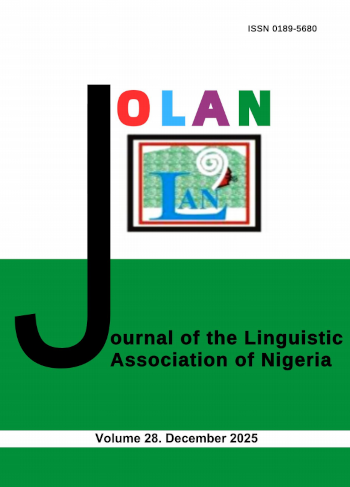Understanding Wh-Movement in Tiv: What Moves Why and To Where
Keywords:
Tiv language, movement, wh-questions, PPTAbstract
Movement is a complex syntactic process whose properties have been elucidated for over half a century of formal syntactic studies. Nevertheless, the phenomenon of movement has continued to intrigue scholars particularly because of the varying asymmetries that exist across languages. This paper sets out to examine syntactic movement in the Tiv language, with particular focus on identifying syntactic units that move, their motivations as well as their landing sites. Specifically, the paper’s main goal is to determine asymmetrical variations in the selected language. The take off point is Chomsky’s Principles and Parameter theory. The paper examines samples of wh question constructions with the view to note the shared/common features (principles) and the interlinguistic variation (parameters) as stipulated by UG. The analysis shows evidence of movement of wh-elements from structural positions within the IP to the Spec-CP field of a matrix clause. The findings also reveal that preposed Qws also pied-pipe adjunct prepositions. The result also shows that wh-movement in Tiv is triggered by a [+focus] feature rather than a [+wh] feature as is the case with most wh-movement languages. The analyses suggest that the landing site of permutated wh-elements is correspondingly a [+focus] position within the Spec-CP field. The paper recommended that the complementiser domain in Tiv be explored further in relation to understanding functional projections in the language.
References
Amfani, A. H. (1996). Aspects of agreement relations in Hausa clause structure. Ph.D Thesis, University of Ibadan, Nigeria.
Bresnan, J. & Mchombo, S. (1987). Topic, pronoun and agreement in Chichewa. Language 63 (pp. 741–782).
Carnie, A. (2006). Syntax: A generative introduction. Oxford: Blackwell Publishers.
Cheng, L. (1991). On the typology of wh-questions. Ph.D thesis, Massachusetts Institute of Technology.
Chomsky, N. (1977). On wh-movement. In P. Culicover, T. Wason & A. Akmajian (Eds.),Formal syntax. (Pp 71-132). New York: Academic Press.
Chomsky, N. (1981). Lectures on government and binding. Dordrecht: Foris.
Chomsky, N. (2000). Minimalist inquiries: The framework. In R. Martin, D. Micheal & J.Uriagereka (Eds.), Step by Step: Essays on Minimalist Syntax in honour of H. Lasnik. (pp. 89-155). Cambridge: MIT Press.
Huang, C. T. (1982) Move WH in a language without WH movement. The Linguistic Review 1: (pp 369-416).
Mbah, B.M. (2006). GB syntax: A minimalist theory and application to Igbo. Enugu: Association of Nigerian Authors.
Ndimele, O. M. (1994). On the nature of wh-questions in Echie. Journal of West African Languages, 24, (pp. 31–43).
Pesetsky, D. (2000). Phrasal movement and its kin. Cambridge, Massachusettes: MIT Press.
Postal, P. M. (1998) three investigations of extraction. Cambridge: Cambridge Massachusetts:MIT Press.
Radford, A. (1988). Transformational grammar: A first course. Cambridge: CUP
Rizzi, L. (1997). The fine structure of the left periphery. In L Haegeman, (Edt.), Elements of Grammar. (pp. 281- 337). Dordrecht: Kluwer Publishers.
Ross, J.R. (1967). Constraints and variables in syntax. Ph.D Thesis. Massachusetts Institute of Technology.
Sabel, J. (2002). Malagasy as an optional multiple wh-fronting language. In C. Boeckx & K. K. Grohmann, (Eds.), Multiple wh-fronting, (pp, 229-254). Amsterdam: John Benjamins.
Takahashi, S. (2010). The hidden side of clausal complements. Natural Language and Linguistics Theory 28, (p 343 - 380)
Wasike, A. K. (2007). The left periphery, wh-in-situ and A-bar movement in Lubukusu and other Bantu languages. A Ph.D thesis, Cornell University














